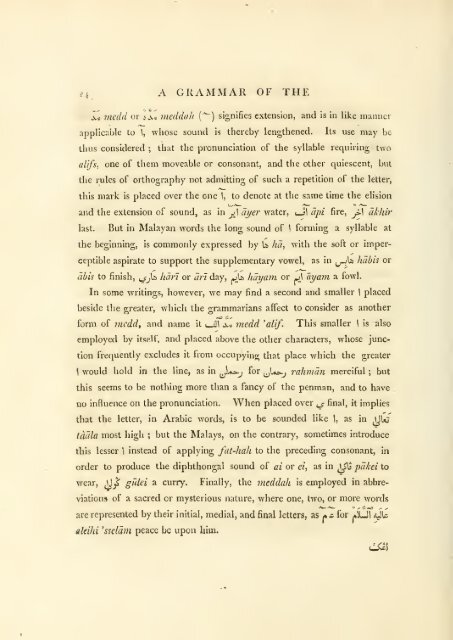A grammar of the Malayan language, with an introduction and praxis..
A grammar of the Malayan language, with an introduction and praxis..
A grammar of the Malayan language, with an introduction and praxis..
You also want an ePaper? Increase the reach of your titles
YUMPU automatically turns print PDFs into web optimized ePapers that Google loves.
24, A GRAMMAR OF THE<br />
.v< medd or i\x« ineddali [''^) signifies extension, <strong>an</strong>d is in like m<strong>an</strong>ner<br />
applicable to 1, whose sound is <strong>the</strong>reby leng<strong>the</strong>ned. Its use may be<br />
thus considered ; that <strong>the</strong> pronunciation <strong>of</strong> <strong>the</strong> syllable requiring tv.o<br />
alifs, one <strong>of</strong> <strong>the</strong>m moveable or conson<strong>an</strong>t, <strong>an</strong>d <strong>the</strong> o<strong>the</strong>r quiescent, but<br />
<strong>the</strong> rules <strong>of</strong> orthography not admitting <strong>of</strong> such a repetition <strong>of</strong> <strong>the</strong> letter,<br />
this mark is placed over <strong>the</strong> one I, to denote at <strong>the</strong> same time <strong>the</strong> elision<br />
<strong>an</strong>d <strong>the</strong> extension <strong>of</strong> sound, as in ^.^1 at/er water, uJl api fire, J^\ akhir<br />
last. But in <strong>Malay<strong>an</strong></strong> words <strong>the</strong> long sound <strong>of</strong> \ forming a syllable at<br />
<strong>the</strong> beginning, is commonly expressed by U ha^ <strong>with</strong> <strong>the</strong> s<strong>of</strong>t or imper-<br />
ceptible aspirate to support <strong>the</strong> supplementary vowel, as in ^^la }iabh or<br />
abis to finish, j^^U. hari or art day, *jU) hayam or J\ ay<strong>an</strong>i a fowl.<br />
In some writings, however, we may find a second <strong>an</strong>d smaller \ placed<br />
beside <strong>the</strong> greater, which <strong>the</strong> <strong>grammar</strong>i<strong>an</strong>s affect to consider as <strong>an</strong>o<strong>the</strong>r<br />
form <strong>of</strong> mcdd, <strong>an</strong>d name it i_a!l j^o medd 'alif. This smaller \ is also<br />
employed by itself, <strong>an</strong>d placed above <strong>the</strong> o<strong>the</strong>r characters, whose junc-<br />
tion frequently excludes it from occupying that place which <strong>the</strong> greater<br />
\ would hold in <strong>the</strong> line, as in ^^.*s^J for ^Ue-; rahmdn merciful ; but<br />
this seems to be nothing more th<strong>an</strong> a f<strong>an</strong>cy <strong>of</strong> <strong>the</strong> penm<strong>an</strong>, <strong>an</strong>d to have .<br />
no influence on <strong>the</strong> pronunciation. When placed over ^_s final, it implies<br />
that <strong>the</strong> letter, in Arabic words, is to be sounded like 1, as in ^jjUi-<br />
tdcila most high ; but <strong>the</strong> Malays, on <strong>the</strong> contrary, sometimes introduce<br />
this lesser \ instead <strong>of</strong> applying fat-halt to <strong>the</strong> preceding conson<strong>an</strong>t, in<br />
order to produce <strong>the</strong> diphthongal sound <strong>of</strong> ai or ei, as in J^S'lS pakei to<br />
wear, /jjf giilei a curry. Finally, <strong>the</strong> meddah is employed in abbre-<br />
viations <strong>of</strong> a sacred or mysterious nature, where one, two, or more words<br />
are represented by <strong>the</strong>ir initial, medial, <strong>an</strong>d final letters, as * a for *LJ1

















